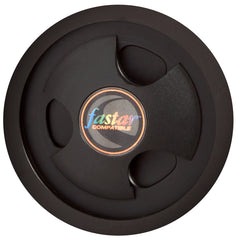Fastar Technology

Would you rather? Would you rather image at f/10 or f/2? Celestron developed Fastar technology to give imagers the flexibility to do both. Fastar unleashes the speed of your optical tube, making it up to 28x times faster. By removing the secondary mirror, imagers can place their DSLR or astroimaging camera on the front of the optical tube to image with a faster focal ratio and a wider field-of-view. In some situations, this may enable you image without guiding due to the shorter exposure time.
A Brief History
In the late 90s, when film cameras were phasing out and digital cameras were coming in, Celestron joined forces with Santa Barbara Instruments Group (SBIG) to meet the demand of astroimagers. Together, the two companies produced a revolutionary add-on to the Schmidt-Cassegrain optical tubes, Fastar. In early 2000, Celestron discontinued the Fastar add-on but continued to offer Fastar-compatible optical tubes to meet the new challenges and needs of CCD astroimaging while retaining very good observing and astrophotography performance.
To this day, our customers continue to praise the Fastar system for greatly reducing exposure times for astroimagers, increasing the ability to use larger imaging sensors, and eliminating the need for secondary wide-field telescopes.
How Does it Work?

|
 |
 |
On the left diagram shown above, you will see a standard Schmidt-Cassegrain and EdgeHD optical tube being used at f/10 or f/11. By removing the secondary mirror as shown in the middle image, you can transform your optical system quickly and easily to f/2, as shown on the right.
Why Fastar makes a big difference for imagers
Aside from the obvious time savings, Fastar-compatible optical tubes provide amateur astronomers with the versatility of two different style optical tubes in one unit. An imager can capture an image from the rear cell or the front cell, providing very different results. With Fastar, the light entering the telescope only bounces off the primary mirror and not the secondary. More light hits the CCD, offering greater detail in images.

When imaging at the rear cell or doing long exposures, the telescope must mounted on an equatorial mount or an alt-azimuth mount equipped with a wedge. The mount will also need to be guided during the exposure. But due to the speed of Fastar technology, it’s possible to image unguided—even on an alt-azimuth without a wedge. Fastar provides the easiest and fastest means of imaging deep-sky celestial objects!
Fastar - Cameras
There are two types of cameras you can use with Fastar, an astroimaging camera or a DSLR. Either way, you will need to reach out to a third party vendor that sells Fastar or Hyperstar equipment to obtain the proper lens assembly.

|
 |
One thing to note: consider the size of the camera body and the cables you plan to use. These items may block additional light coming into the telescope and add diffraction spikes. Learn more about diffraction spikes here.
Is my Celestron telescope Fastar-compatible?
Most of Celestron’s Schmidt Cassegrain and EdgeHD optical tubes are Fastar-compatible. To identify if your optical tube is compatible, look for the Fastar logo on the secondary mirror cell assembly or housing. Older Celestron models may not have the logo, but do allow you to unscrew the secondary mirror.
Here is a list of current Celestron telescopes that are Fastar-compatible:
| Optical Tubes | |
|---|---|
| Schmidt Cassegrain 14” | EdgeHD 14” |
| Schmidt Cassegrain 11” | EdgeHD 11” |
| Schmidt Cassegrain 9.25” | EdgeHD 9.25” |
| Schmidt Cassegrain 8” | EdgeHD 8” |
| Schmidt Cassegrain 6” | |
Fastar Compatible Telescopes
-
NexStar 8SE Computerized Telescope
(2,038)Regular price $1,499.00Regular price$1,699.00Sale price $1,499.00Free Ground Shipping! Contiguous USA onlySale -
NexStar Evolution 8 Telescope
(148)Regular price $2,399.00Regular price -
Advanced VX 8" Schmidt-Cassegrain Telescope
(26)Regular price $2,499.00Regular price -
CPC Deluxe 1100 HD Computerized Telescope
(15)Regular price $4,699.00Regular price$5,499.00Sale price $4,699.00Free Ground Shipping! Contiguous USA onlySale -
CPC Deluxe 800 HD Computerized Telescope
(9)Regular price $2,799.00Regular price$3,399.00Sale price $2,799.00Free Ground Shipping! Contiguous USA onlySale -
EdgeHD 8" Optical Tube Assembly (CGE Dovetail)
(9)Regular price $1,699.00Regular price -
Used - NexStar 8SE Computerized Telescope
Regular price $1,399.97Regular price$1,699.00Sale price $1,399.97Free Ground Shipping! Contiguous USA onlyUsed Item -
EdgeHD 9.25" Optical Tube Assembly (CGE Dovetail)
(3)Regular price $3,099.00Regular price -
CPC 1100 GPS (XLT) Computerized Telescope
(118)Regular price $3,699.00Regular price$4,299.00Sale price $3,699.00Free Ground Shipping! Contiguous USA onlySale -
EdgeHD 11" Optical Tube Assembly (CGE Dovetail)
(3)Regular price $4,499.00Regular price -
CGX Equatorial 1100 HD Telescope
Regular price $6,599.00Regular price










